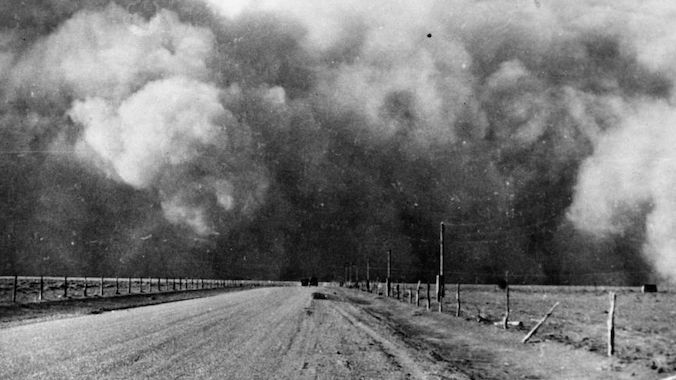The New Dust Bowl Is Upon Us
Photo by United States Department of Agriculture/PhotoQuest/Getty Images
Kansas is a wheat-growing powerhouse — usually. Between 1981 and 2020, the state produced almost 360 million bushels of wheat per year, or almost a quarter of the total U.S. output. Russia’s 2022 invasion of Ukraine, itself a globally important wheat producer, put even more pressure on the U.S., which planted 11 percent more winter wheat in response. Climate change had other ideas.
A study published on Wednesday in Science Advances analyzed the unprecedented drought across multiple years that plagued the plains states in 2022 and 2023, and found that Kansas wheat output fell by a remarkable 37 percent compared to that 1981-2020 period — a decline the authors wrote was “reminiscent of the Dust Bowl Years in the 1930s.”
The fall was due to both crop abandonment and reduced yield, both of which were connected to extreme climatic events. The drought seen in Kansas in 2022 and into 2023 was unprecedented: the state saw 60 percent less precipitation than normal, setting a record that dates back to 1896. The drought in the fall of 2022 hampered the winter wheat growth, contributing to farmers abandoning huge amounts of their crop; the persistent drought into the next year then stunted the wheat’s summer growth, reducing the yields the unabandoned crops actually produced.
A big contributor here was the three consecutive years of La Niña conditions, the Pacific Ocean weather pattern that has an overall cooling effect on the planet but also changes localized precipitation patterns. Those changes include decreased precipitation in many parts of the U.S. — in fact, the horrific drought that, along with the land degradation wrought by decades of careless farming practices, helped usher in the actual Dust Bowl in the 1930s has been connected to a La Niña event.
In the more recent case, the combination of rising temperatures and the detrimental weather pattern brought about the wheat catastrophe. And it won’t be the last time: climate change is almost certainly making those La Niña and warmer cousin El Niño events worse. “Extreme El Niño and La Niña events may increase in frequency from about one every 20 years to one every 10 years by the end of the 21st century under aggressive greenhouse gas emission scenarios,” NOAA expert Michael McPhaden said a few years ago. “The strongest events may also become even stronger than they are today.”
That means the Dust Bowl-like conditions of 2022-2023 are likely to keep coming, and agricultural losses in some areas are almost definitely going to get worse. Other studies bear out climate change’s more general impact on U.S. agriculture: for example, one from 2023 found that a one degree Celsius increase in temperature will correspond with an additional 3.2 million failed agricultural acres — almost one percent of all U.S. output. A three-degree warming scenario — one we’re more or less still on track for, on the high end of current emissions trajectories — would cause 11 million acres to fail, up to three percent of the total.
The authors of the new study suggest that recognizing the importance of fall drought on crop abandonment the following year in particular could offer some lessons. Farmers could adjust planting schedules, or change water management strategies proactively, when drought conditions are present in the fall. Of course, there are likely limits to this sort of thing; Kansas’s 37 percent decline in wheat production was the worst of any recent year and actually beat out all the actual Dust Bowl years but one, 1935. As with most every record that falls these days, don’t expect this one to last.